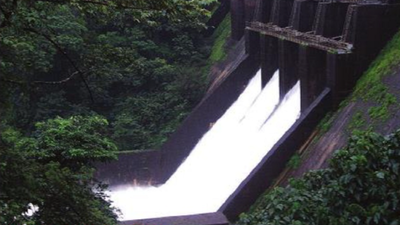Top Searches
As Goa heads into summer, state's reservoirs 50-70% full

The level in the Anjunem dam is at 50%
PANAJI: As the mercury begins to rise in Goa, the state is heading towards summer with its water reservoirs between 50% and 70% full.
The Selaulim reservoir - located in Ugem in Sanguem - which meets drinking water requirement of most of South Goa, is presently 73% full. With plenty of rainfall received last July, the reservoir began overflowing from its duckbill spillway on July 7, 2022, and water levels in the dam were even at 110% of capacity during the peak of the last monsoon, as per levels recorded by the water resources department.

The reservoir of Chapoli in Canacona, which provides raw water for treatment to quench the thirst of Canacona taluka, has water levels at 72% currently.
ater stored in all the reservoirs in Goa, including Tillari dam in Sindhudurg, Maharashtra, up to September 2022 during the monsoon season, will be used for treatment and to meet drinking water requirements in Goa until the next monsoon 2023 arrives.
At the Amthane reservoir, which provides water to Bardez and parts of Bicholim and Pernem taluka, the water levels are at 69%.
From November to January, the canals from Tillari supplying raw water to Goa were taken up for major repairs after nearly 22 years. This had put additional pressure on the water reserves for the talukas of Bardez, Bicholim, and Pernem. When required, water from the rivers are pumped into the Amthane reservoir to replenish it.
At the Anjunem reservoir on River Costi in Sattari, the water levels arepresently at 56%. The minor reservoirs of Gaunem and Panchwadi are 65% and 48% full, respectively.
Goa also has over 300 vasant bandharas over rivers, where raw water is stored to be used in case of shortages during the summer.
There are bandharas on the Chandel and the Kalana, from where the PWD pumps water for supply to the Chandel plant to meet Pernem taluka’s water requirements.
From the bandharas on the Chapora and the Sal, water is pumped into the reservoir at Amthane, which is used at the Amthane water treatment plant. This helps meet the drinking water requirements in Bardez and Bicholim.
There are 14 other bandharas on the Khandepar, from where water is used for the Opa water treatment plant.
The Selaulim reservoir - located in Ugem in Sanguem - which meets drinking water requirement of most of South Goa, is presently 73% full. With plenty of rainfall received last July, the reservoir began overflowing from its duckbill spillway on July 7, 2022, and water levels in the dam were even at 110% of capacity during the peak of the last monsoon, as per levels recorded by the water resources department.

The reservoir of Chapoli in Canacona, which provides raw water for treatment to quench the thirst of Canacona taluka, has water levels at 72% currently.
ater stored in all the reservoirs in Goa, including Tillari dam in Sindhudurg, Maharashtra, up to September 2022 during the monsoon season, will be used for treatment and to meet drinking water requirements in Goa until the next monsoon 2023 arrives.
At the Amthane reservoir, which provides water to Bardez and parts of Bicholim and Pernem taluka, the water levels are at 69%.
From November to January, the canals from Tillari supplying raw water to Goa were taken up for major repairs after nearly 22 years. This had put additional pressure on the water reserves for the talukas of Bardez, Bicholim, and Pernem. When required, water from the rivers are pumped into the Amthane reservoir to replenish it.
At the Anjunem reservoir on River Costi in Sattari, the water levels arepresently at 56%. The minor reservoirs of Gaunem and Panchwadi are 65% and 48% full, respectively.
Goa also has over 300 vasant bandharas over rivers, where raw water is stored to be used in case of shortages during the summer.
There are bandharas on the Chandel and the Kalana, from where the PWD pumps water for supply to the Chandel plant to meet Pernem taluka’s water requirements.
From the bandharas on the Chapora and the Sal, water is pumped into the reservoir at Amthane, which is used at the Amthane water treatment plant. This helps meet the drinking water requirements in Bardez and Bicholim.
There are 14 other bandharas on the Khandepar, from where water is used for the Opa water treatment plant.

About the Author
Gauree MalkarnekarGauree Malkarnekar, senior correspondent at The Times of India, Goa, maintains a hawk's eye on Goa's expansive education sector. And when she is not chasing schools, headmasters and teachers, she turns her focus to crime. Her entry into journalism was purely accidental: a trained commercial artist, she landed her first job as a graphic designer with a weekly, but less than a fortnight later set aside the brush and picked up the pen. Ever since she has not complained.
Start a Conversation
FOLLOW US ON SOCIAL MEDIA
FacebookTwitterInstagramKOO APPYOUTUBE









